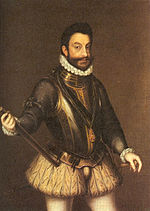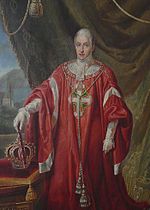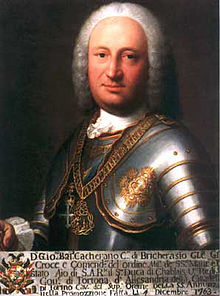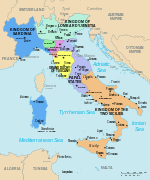Order of Saints Maurice and Lazarus
| Royal Order of Saints Maurice and Lazarus | |
|---|---|
 Insignia of a Commander of the order | |
| Awarded by | |
| Type | Dynastic order of chivalry |
| Established | 16 September 1572 (Order of Saint Maurice: 1434) (Order of Saint Lazarus: 1119) |
| Royal house | House of Savoy |
| Religious affiliation | Catholic |
| Motto | FERT |
| Eligibility | Military, civilian |
| Awarded for | Distinguished merits |
| Status | Currently Constituted |
| Grand Master | Prince Vittorio Emanuele, Prince of Naples |
| Chairman of the Council | Prince Emanuele Filiberto of Savoy, Prince of Venice |
| Grades | Grand Cordon, Special Class Grand Cordon Grand Officer Commander Officer Knight/Dame |
| Statistics | |
| Total inductees | Circa 2,000 |
| Precedence | |
| Next (higher) | Royal Supreme Order of the Most Holy Annunciation |
| Next (lower) | Royal Order of the Crown |
Ribbon bar | |
The Order of Saints Maurice and Lazarus (Italian: Ordine dei Santi Maurizio e Lazzaro) is a Roman Catholic dynastic order of knighthood bestowed by the House of Savoy, founded in 1572 by Emmanuel Philibert, Duke of Savoy, through amalgamation approved by Pope Gregory XIII of the Order of Saint Maurice, founded in 1434, with the medieval Order of Saint Lazarus, founded circa 1119, considered its sole legitimate successor. The Grand Master is Vittorio Emanuele, Prince of Naples, since 1983.
The order was formerly awarded by the Kingdom of Italy (1861–1946) with the heads of the House of Savoy as the Kings of Italy. Originally a chivalric order of noble nature, it was restricted to subjects of noble families with proofs of at least eight noble great-grandparents. The order's military and noble nature was and is still combined with a Roman Catholic character.
After the abolishment of the monarchy and the foundation of the Italian Republic in 1946, the legacy of the order is maintained by the pretenders of the House of Savoy and the Italian throne in exile.
The order is estimated to include about 2,000 members around the world.
Contents
1 History
1.1 Order of Saint Lazarus (1119)
1.2 Order of Saint Maurice (1434)
1.3 Order of Saints Maurice and Lazarus (1572)
1.3.1 Kingdom Italy (1861–1946)
1.3.2 Dynastic chivalric order bestowed in exile (1946-)
2 Organisation
2.1 Grades
3 Insignia
4 List of Grand Masters
5 Recipients in selection
5.1 Royalties
5.2 Military
5.3 Politics
5.4 Culture
5.5 Ecclesials
5.6 Sciences
5.7 Philanthropy
6 See also
7 References
8 Notes
9 External links
History

Emmanuel Philibert, Duke of Savoy (1528–1580), founder and first Grand Master of the amalgated Order of Saints Maurice and Lazarus in recognition by Pope Gregory XIII.
.mw-parser-output .templatequote{overflow:hidden;margin:1em 0;padding:0 40px}.mw-parser-output .templatequote .templatequotecite{line-height:1.5em;text-align:left;padding-left:1.6em;margin-top:0}
The undisputed continuation of the Order of St. Lazarus is in the Order of Saints Maurice and Lazarus, which continues under the pretenders to the Italian Crown.
— Michael Foster[1]
Both crosses from its two forerunners still exist in the insignia of their subsequent successor, today's Order of Saints Maurice and Lazarus, founded by amalgation in 1572.

The green-enameled Maltese Cross of the Order of Saint Lazarus, founded c. 1119

The white-enameled cross bottony of the Order of Saint Maurice, founded in 1434

Combined Maltese Cross and cross bottony,
of the Order of Saints Maurice and Lazarus
Order of Saint Lazarus (1119)
The Order of Saint Lazarus, founded c. 1119, can be traced to the establishment around 1100, of a hospital for leprosy in Jerusalem, Kingdom of Jerusalem, by a group of crusaders who called themselves "Brothers of Saint Lazarus".[2] From its inception, the order was concerned with the relief of leprosy, and many of its members were lepers who had been knights in other orders. It became rich, its practices dubious, and its funds eventually abused. With the fall of Acre in 1291, the Knights of Saint Lazarus emigrated from the Holy Land and Egypt and settled in France and, in 1311, in Naples. In the 16th century, the order declined in credibility and wealth. With papal support, the Duke of Savoy became Grand Master in 1572. Before its transfer to the House of Savoy, the Order of Saint Lazarus maintained a number of leper hospitals, including an institution in the Italian city of Capua.
Order of Saint Maurice (1434)
The Order of Saint Maurice was established in 1434 by Amedeo VIII of Savoy, during his stay in the Ripaglia hermitage near Thonon, named after Saint Maurice of the Theban Legion. From its beginning, it was a military order.[2] The order declined, but in 1572 was reestablished by Pope Pius V at the instigation of the then-Duke of Savoy.
Order of Saints Maurice and Lazarus (1572)

King and Grand Master Charles Felix of Sardinia in ceremonial robe of the Order of Saints Maurice and Lazarus.

King Charles Albert of Sardinia in ceremonial robe.
In 1572, Pope Gregory XIII united the Order of Saint Lazarus in perpetuity with the Crown of Savoy. Emmanuel Philibert, Duke of Savoy, merged it with the Savoyan Order of Saint Maurice, and thenceforth the title of Grand Master of the Order of Saints Maurice and Lazarus was hereditary in that house. The pope gave him authority over the vacant commanderies everywhere, except in the states of the King of Spain, which included the greater part of Italy. In England and Germany, these commanderies were suppressed by the Protestant reformation.
The new organisation was charged to defend the Holy See as well as continue to assist lepers. The war galleys of the order fought against the Ottoman Empire and the Barbary pirates. When leprosy again broke out, the order founded a hospital in Aosta in 1773.
Kingdom Italy (1861–1946)

King and Grand Master Umberto II of Italy visiting Cairo, Egypt.
With the Italian unification (1860-1871), the order became a de facto Italian state order for military and civilian merits, consisting of five classes: Knight Grand Cross, Knight Grand Officer, Knight Commander, Knight Officer and Knight.
The formerly related Maurician medal for Military Merit of fifty years, established in 1839, was one of the few medals not suppressed by the Italian republic, becoming the Maurician medal of Merit for 50 years military career in 1954.[3]
Brought back in favour by King Victor Emmanuel II of Italy, the order was sparingly conferred for distinguished service in military and civilian affairs as an exclusive award compared with the more common Order of the Crown of Italy.[2]
Dynastic chivalric order bestowed in exile (1946-)
After Italy became a republic in 1946, the order was effectively replaced by the Order of Merit of the Italian Republic. Since 1951 it has not been officially recognised by the Italian state.
Organisation

Great coat of arms of the royal family of Italy, including the insignia of the order.

Vittorio Emanuele, Prince of Naples (right), and his third cousin Prince Amedeo, Duke of Aosta (b. 1943) (left).
Insignia of the grades.

Insignia of the order.

Insignia of a Commander of the Order of Saints Maurice and Lazarus.

Basilica Mauriziana in Turin, Italy, associated with the Order of Saints Maurice and Lazarus.
The House of Savoy in exile continues to bestow the order on recipients eminent in the public service, science, art, letters, trade, and charitable works. While the continued use of those decorations conferred prior to 1951 is permitted in Italy, the crowns on the ribbons issued before 1946 must be substituted for as many five pointed stars on military uniforms.[4] Eventually, it became a requirement for a person to have already received the Order of Saints Maurice and Lazarus before receiving the Order of the Most Holy Annunciation.
The generally accepted Grand Master of the order is Vittorio Emanuele, Prince of Naples, the current head of the House of Savoy. However, some of Vittorio Emanule's policies as Grand Master have generated controversy.
In 2006, Vittorio Emanuele's third cousin, Prince Amedeo, Duke of Aosta (b. 1943), declared himself head of the Savoy dynasty and thus Sovereign de jure. For this reason, the grand magistry is now contested.
Grades
Knight Grand Cordon, Special Class, For the Grand Master of the Order; who wear a sash on the right shoulder to the left hip, the badge as well as star which is worn on the left side of the stomach are in Brilliants
Knight/Dame Grand Cordon, Wear a sash on the right shoulder to the left hip and the badge as well as star are worn on the left side
Knight/Dame Grand Officer, who wear a necklet plus the star on the left chest; (ladies in: uniform = necklet with the star on the left side of the stomach, daydress = bow formed necklet worn on the left side of the chest with out the star, evening wear = bow formed necklet worn on the left side of the chest with the star on the left chest)
Knight/Dame Commander, who wear a necklet; (ladies in: uniform = necklet, daydress = bow formed necklet worn on the left side of the chest, evening wear = bow formed necklet worn on the left side of the chest)
Knight/Dame Officer, who wear a medal in Gold on the left side of the chest; (ladies in: uniform = necklet, daydress and evening wear = bow formed medal worn on the left side of the chest)
Knight/Dame, who wear a smaller Medal in Silver on the left side of the chest; (ladies in: uniform = necklet; daydress and evening wear = bow formed medal worn on the left side of the chest)
Insignia
- The badge of the order is in gilt, consists of a white-enameled cross bottony of the Order of Saint Maurice, with a green-enameled Maltese Cross, the Cross of the Order of Saint Lazarus, placed in saltire between the arms of the cross botonny. The badge of each class except that of Knight and Dame is topped by a gilt crown.
- The star of the Order is a silver faceted star, with eight points for Grand Cross and four points for Grand Officer, and with the badge (minus the crown) superimposed upon it.
- The breast cross for the Commander "jus patronato" class is identical to the badge, minus the crown.
- The ribbon of the Order is apple green, with slight variations for the several classes:
| Ribbon | Class (English) | Full title in Italian |
|---|---|---|
| 1st Class / Knight Grand Cross | Cavaliere di Gran Croce dell'Ordine dei Santi Maurizio e Lazzaro | |
| 2nd Class / Commander First Class (from 1865 Grand Officer) | Commendatore di prima classe (dal 1865 Grande Ufficiale) dell'Ordine dei Santi Maurizio e Lazzaro | |
| 3rd Class / Commander | Commendatore dell'Ordine dei Santi Maurizio e Lazzaro | |
| 4th Class / Officer | Ufficiale dell'Ordine dei Santi Maurizio e Lazzaro | |
| 5th Class / Knight | Cavaliere dell'Ordine dei Santi Maurizio e Lazzaro | |
Maurizian Medal (not members of the order) | Medaglia Mauriziana pel Merito Militare di dieci lustri |
List of Grand Masters
Emmanuel Philibert, Duke of Savoy (1572-1580)
Charles Emmanuel I, Duke of Savoy (1580-1630)
Victor Amadeus I, Duke of Savoy (1630-1637)
Francis Hyacinth, Duke of Savoy (1637-1638)
Charles Emmanuel II, Duke of Savoy (1638-1675)
Victor Amadeus II of Sardinia (1675-1731)
Charles Emmanuel III of Sardinia (1732-1773)
Victor Amadeus III of Sardinia (1773-1796)
Charles Emmanuel IV of Sardinia (1796-1802)
Victor Emmanuel I of Sardinia (1802-1824)
Charles Felix of Sardinia (1824-1831)
Charles Albert of Sardinia (1831-1849)
Victor Emmanuel II of Italy (1849-1878)
Umberto I of Italy (1878-1900)
Victor Emmanuel III of Italy (1900-1946)
Umberto II of Italy (1946-1983)
Vittorio Emanuele, Prince of Naples (1983-) (contested by Prince Amedeo, Duke of Aosta 1983-)
Recipients in selection

Portrait d'un gonfalonier (1622) painted by Artemisia Gentileschi, carrying the cross on the breast and the ribbon around the chest.

General Giovanni Battista Cacherano di Bricherasio, Knight Grand Cross of the Order of Saints Maurice and Lazarus.

Edmond de Sélys Longchamps
Royalties
- Emperor Franz Joseph I of Austria
- Emperor Wilhelm II of the German Empire
- Emperor Nicholas II of Russia
- Emperor Haile Selassie of Ethiopia
- King Zog I of Albania
- King George V of the United Kingdom
- King Mozaffar ad-Din Shah Qajar of Persia
Prince and Grand Master Andrew Bertie of the Sovereign Military Order of Malta
Maharaja Jagatjit Singh
- Maharajah Juddha Shumsher Jung Bahadur Rana
Military
General of the Armies John Pershing
General of the Army George Marshall
Field Marshal Walther von Brauchitsch
- General Matthew Bunker Ridgway
- General François d'Astier de La Vigerie
- General Tasker H. Bliss
- General Mark W. Clark
- General Ira C. Eaker
- General Peyton C. March
- Admiral Ernesto Burzagli[5]
- Major General Ulysses S. Grant III
- Brigadier General Billy Mitchell
- Naval Captain Emilio Faà di Bruno
- Senior Systems Manager (CF 3) Jonas Arnell
Politics
- Henri Jaspar
- Charles de Broqueville
- Charles Rogier
- Baron Edmond de Sélys Longchamps
- President Porfirio Díaz
- Dr Hans Frank, 26.9.1936[6]
- Minister of foreign affairs Giustino Fortunato[7]
- Member of Parliament Cristiana Muscardini
- Diplomat Jose Maria Quijano Wallis[8]
- Luigi, Count Cibrario
Baron Oswald von Richthofen, State Secretary for Foreign Affairs of the German Empire - August 1902 - during the visit to Germany of King Victor Emmanuel III of Italy[9]
- President of the 1904 Louisiana Purchase Exposition and Former St. Louis Mayor David R. Francis[10]
- Mayor Rudolph Giuliani of New York City (2001) Cavaliere di Gran Croce (Motu Proprio)[11]
Culture
- Architect Carlo Rainaldi
Ecclesials
- Pietro Tacchi Venturi
Sciences
- Charles Combes
- Giuseppe Peano
Philanthropy
- Thomas Hanbury
- J. P. Morgan
See also
- List of Italian orders of knighthood
- Dynastic order of knighthood
- Order of Merit of the Italian Republic
References
Miller, Michael (2015). Leaders Of The Storm Troops Volume 1. England: Helion & Company. ISBN 978-1-909982-87-1..mw-parser-output cite.citation{font-style:inherit}.mw-parser-output q{quotes:"""""""'""'"}.mw-parser-output code.cs1-code{color:inherit;background:inherit;border:inherit;padding:inherit}.mw-parser-output .cs1-lock-free a{background:url("//upload.wikimedia.org/wikipedia/commons/thumb/6/65/Lock-green.svg/9px-Lock-green.svg.png")no-repeat;background-position:right .1em center}.mw-parser-output .cs1-lock-limited a,.mw-parser-output .cs1-lock-registration a{background:url("//upload.wikimedia.org/wikipedia/commons/thumb/d/d6/Lock-gray-alt-2.svg/9px-Lock-gray-alt-2.svg.png")no-repeat;background-position:right .1em center}.mw-parser-output .cs1-lock-subscription a{background:url("//upload.wikimedia.org/wikipedia/commons/thumb/a/aa/Lock-red-alt-2.svg/9px-Lock-red-alt-2.svg.png")no-repeat;background-position:right .1em center}.mw-parser-output .cs1-subscription,.mw-parser-output .cs1-registration{color:#555}.mw-parser-output .cs1-subscription span,.mw-parser-output .cs1-registration span{border-bottom:1px dotted;cursor:help}.mw-parser-output .cs1-hidden-error{display:none;font-size:100%}.mw-parser-output .cs1-visible-error{font-size:100%}.mw-parser-output .cs1-subscription,.mw-parser-output .cs1-registration,.mw-parser-output .cs1-format{font-size:95%}.mw-parser-output .cs1-kern-left,.mw-parser-output .cs1-kern-wl-left{padding-left:0.2em}.mw-parser-output .cs1-kern-right,.mw-parser-output .cs1-kern-wl-right{padding-right:0.2em}
Notes
^ "Orders connected to the Order of St. John of Jerusalem". www.orderstjohn.org.
^ abc "ITALY". www.haileybury.com.
^ Established by Royal Magistral Patent dated 19 July 1839, approved by Royal Decree of 21 December 1924 and renewed by Law No. 203(1) of 7 March 1954 Medaglia Mauriziana al Merito di dieci lustri di carriera militare, published in Gazzetta Ufficiale, No. 116, 21 May 1954, as amended by Law No. 1327 of 8 November 1956
^ Ordini Cavallereschi del Regno d'Italia Archived 2010-01-20 at WebCite Corpo della Nobiltà Italiana (retrieved 10 September 2009)
^ Senato della Repubblica: biographical summary
^ Miller 2015, p. 452.
^ Collezione delle Leggi e de'Decreti Reali del Regno delle Due Sicilie, Stamperia reale, 1846, p.85
^ Papel Periódico Ilustrado Volúmen 1 año I Número 1 al 14 Archived 2013-12-03 at the Wayback Machine.
^ "Latest intelligence - The King of Italy in Berlin". The Times (36859). London. 29 August 1902. p. 3.
^ Lab, Missouri Historical Society. "Missouri Historical Society - Find Yourself Here". The Missouri Historical Society is ... Missouri Historical Society and was founded in 1866.
^ "Events: 2001". House of Savoy. Retrieved April 1, 2009.
External links
| Wikimedia Commons has media related to Category:Order of Saints Maurice and Lazarus. |
Sito Ufficiale degli Ordini Dinaastici della Real Casa Savoia (Italian)- The Order of Saints Maurice and Lazarus by L. Mendola
- American Delegation of Savoy Orders




